Periodization Training for Tennis
Part 5
By Dr. Paul Roetert
This article outlines the second half of the tennis specific stretching program developed by USTA Sports Science for players at all levels. In the last article we covered stretches for the arms, shoulders, and torso. This article outlines the stretches for the hips and legs.
As previously stressed, flexibility is key in tennis both for performance and injury prevention. But few people are flexible enough around their joints for the range of motion tennis requires. Following this program on a regular basis will help develop this flexibility and will increase your ability to execute strokes and movement patterns fully. Remember, before stretching, begin with the dynamic warm-up presented in part3 of this series. Then complete both halves of the stretching program.
Again here are the steps to follow to maximize the benefits of the stretching regimen:
- Always warm up for 3-5 minutes as detailed in the previous article. You should break a light sweat.
- Use slow smooth movements, and coordinate this with your breathing.
- Inhale deeply, then exhale as you stretch.
- Take the motion to the point just short of mild pain, then ease back slightly.
- Hold this position for 15 to 20 seconds and breathe normally.
- Repeat the entire procedure 2 or 3 times.
To make greater gains in overall flexibility, perform this same program again AFTER the aerobic portion of your periodization training program, or after a match or an on-court workout.
Hamstring Stretch I
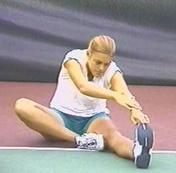 |
Sit with your leg in front, the knee straight and the toes pointing up. Place the bottom of your opposite foot against the extended knee. Keep your back erect and the knee as straight as possible. Now reach forward with both hands toward your foot. Repeat with the other leg.
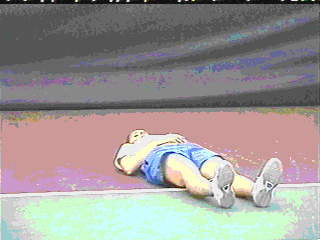 |
Hamstring and Glutes
Lie on your back with your leg bent and bring it to a 90-degree angle at your hip. Grasp the leg with both
hands behind the knee and keep the opposite leg straight. Now straighten the leg and raise it toward your trunk.
Pull back with the hands to gently increase the stretch. Repeat with the other leg.
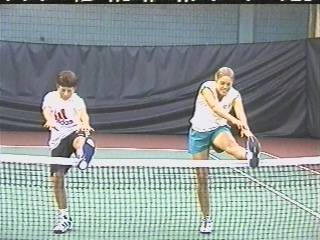 |
Hamstring SuperStretch
Place your leg on any object at about waist height, such as the net. Extend your arms and slowly bend forward at the waist, bringing you trunk toward your thigh. You can intensify the stretch by bringing your toes back toward your face. Repeat with the other leg.
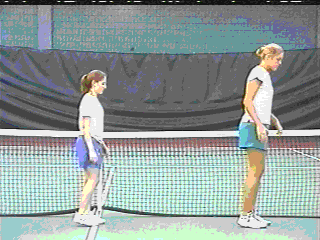 |
Stork Quadriceps Stretch
Stand on one leg, bending the opposite knee and grasp the foot or ankle. Keep your back flat and buttocks tucked
under. Now bend the knee, bringing your foot toward the buttock. Be careful not to twist the knee. Repeat with the
other leg.
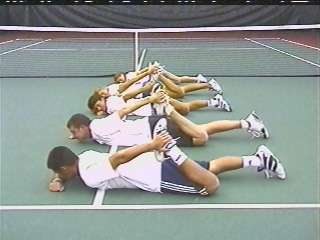 |
Prone Quadriceps Stretch
Lie on your stomach. Bend your knee toward your buttock while grasping the foot or ankle with your hand. Pull the
foot directly up and be careful not to twist the knee. Repeat with the other leg.
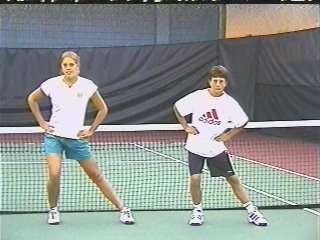 |
Groin Stretch
Place your hands on your hips with your feet spread shoulder width or a little wider. Point your toes slightly
outward, and slowly bend your knee until you feel a stretch in the groin area of the opposite leg. Now roll your
weight onto the inside of the opposite foot to increase the stretch. Repeat with the other leg.
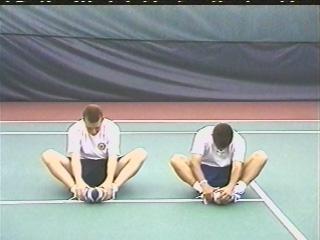 |
Seated Groin Stretch
Sit with the soles of your shoes together, with your knees out, holding your toes. Keep your spine straight and
gently pull forward, bending from the hips and bringing your chest to the feet. Don't round your upper back. Gently
push your knees toward the ground with your elbows.
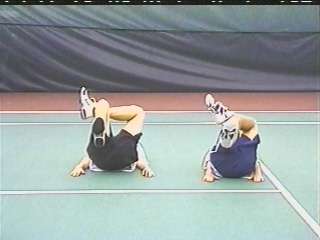 |
Piriformis Stretch
Lie on your back with one knee bent. Place the opposite ankle on top of this knee. Slowly bring the knee toward the chest. You'll feel the stretch in the buttock. Repeat with the other leg.
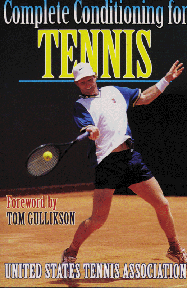 |
To find out more about these and other exercises, check out the USTA authored book: Complete Conditioning for Tennis. |
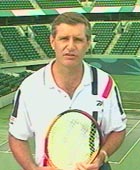 |
Paul Roetert is the Managing Director of the United States Tennis Association's USA Tennis High Performance Program, based in Key Biscayne, Florida. For eleven years Paul was the Administrator of Sport Science for the USTA, where he developed the sport science program, and also served as Vice Chairman of the sport science committee. He has published extensively in the field of tennis, including two books, 16 book chapters and over 100 articles. Paul holds a Ph.D. in biomechanics from the University of Connecticut. Originally from the Netherlands, he and his wife Barbara reside in Miami, Florida. |
|



